Rennie Scaysbrook | June 3, 2016
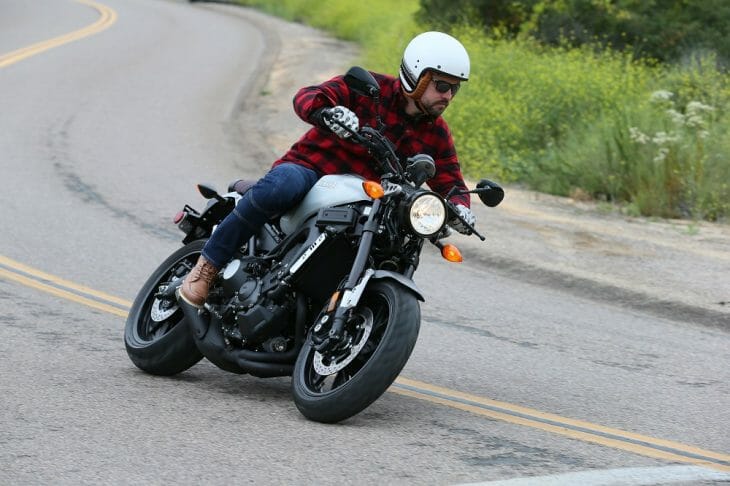 Old-school charm meets new-school cool. The XSR goes and handles the way the FZ-09 always should have.
Old-school charm meets new-school cool. The XSR goes and handles the way the FZ-09 always should have.
The retro scene is alive and well at Yamaha. The Tuning Fork brand has done a better job than most at maximizing the value of its rich heritage of late, releasing not just bikes like this XSR900 but sponsoring a number of bike building competitions that tap into the anti-electronic movement that’s swept across the motorcycle industry over the past 10 years or so.
And that makes the XSR900 all the more interesting. Because this bike, whose style is not too dissimilar to the analog Yamaha XJR1200 that sat in my dad’s garage for a decade or so (unfortunately, the U.S. missed out on that awesome four-cylinder beast as it wasn’t officially imported here) is loaded to the brim with the kind of electronic gizmos hipsters eating gluten-free tacos would cry into their perfectly oiled beards over. Stuff like fuel injection and alternate riding maps, ABS, traction control and (shock!) a digital dash.
Has Yamaha already made this retro theme un-cool? I mean, once something’s gone mainstream…
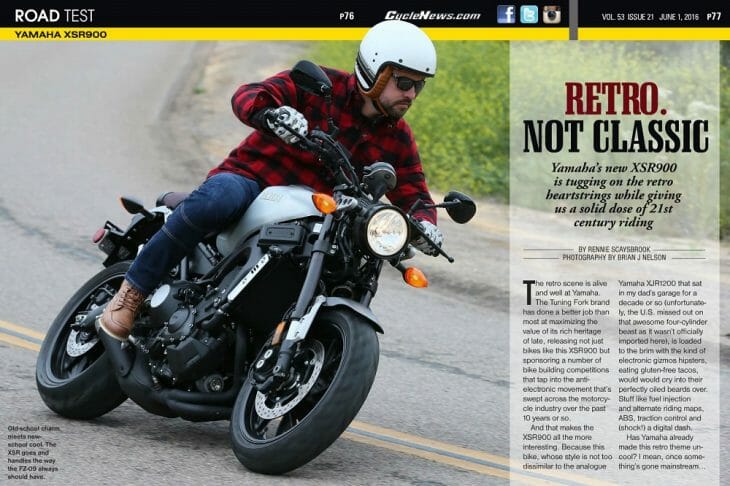 You can read the original magazine story by clicking HERE.
You can read the original magazine story by clicking HERE.
Photography by Brian J Nelson
If I hadn’t had the chance to ride the XSR, I’d maybe have to think about my answer to the previous question. But now that I have, I can unquestionably say if all retro-themed bikes performed this good, go ahead and sign me up to the nearest gluten-free taco stand. I might even start using beard oil. Put simply, Yamaha has hit this one out of the park.
Using the same platform as the hooligan bike to end them all, the Yamaha FZ-09, the XSR is a much more rounded package than its batshit-crazy sibling. It’s the bike the FZ-09 could be if it grew up and stopped going to raves.
You get exactly the same 847cc cross-plane crank three-cylinder motor, but those who remember the horrendous throttle response of the first generation FZ-09 will be pleasantly surprised with the XSR. The retro-styled XSR’s acceleration is much smoother from a closed throttle – there’s no longer that horrid thud that was once present when you opened the three 41mm throttle valves – and now you’re met with a smooth gateway to that meaty torque that made the FZ-09 such a sensational bike in the first place.
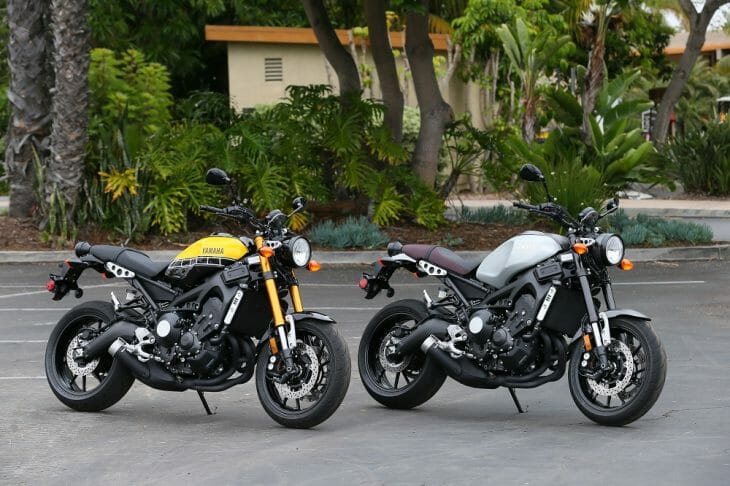 Even though we love our race heritage, our vote goes to the Matte Gray and Aluminum XSR.
Even though we love our race heritage, our vote goes to the Matte Gray and Aluminum XSR.
Not only is the initial throttle response now what it should be, the smoother access to the torque means you can get real nasty on the throttle at any rpm and instead of getting the chassis all in a twist, the XSR just picks up and pulls away, lofting the front wheel ever so slightly right up through the rev range as you laugh your head off, accompanied by one of the best sounding engines in motorcycling. It’s a gluttonous, guilty pleasure, the kind that makes you glad you ride these funny motorbicycle things.
Yamaha has equipped the XSR with three riding modes (A, B, STD) just like the FZ, but there’s really no need to use anything other than B mode. A and STD are a little too abrupt for my tastes – there’s no reduction in power in B mode, just a nicer feeling at the twistgrip which, as previously mentioned, is one of the great things about this bike.
The XSR motor does have one major difference over the FZ-09. Mated to the retro bike is Yamaha’s Assist and Slipper clutch, which basically acts the same as a slipper clutch by reducing the clutch engagement force during downshifting through the slick gearbox and stopping the rear wheel from locking. With three less springs in the clutch, it makes for a more stable chassis under braking and a lighter pull at the lever, which now barely needs anything more than a single finger to operate.
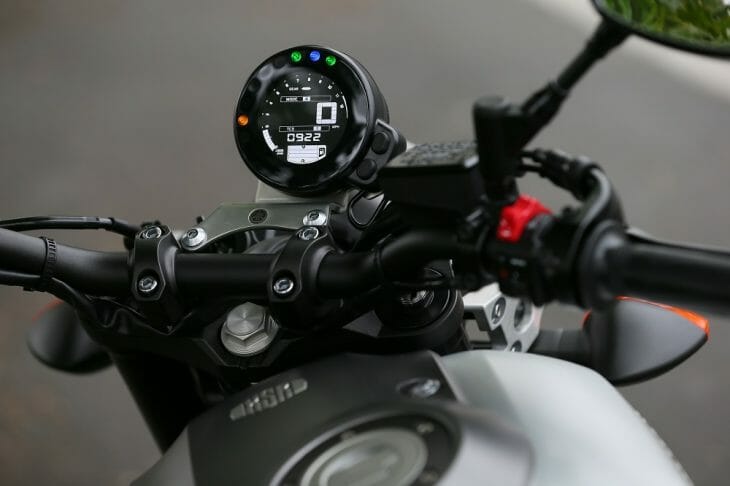 Plenty of modern tech has been shoved into that retro-styled dash.
Plenty of modern tech has been shoved into that retro-styled dash.
One thing that is surprising for such a retro-themed bike is how stiff the chassis is. There’s heavier springs in the fork, which are right on the limit for how stiff I’d like my streetbike to be, and it feels like these should be carried over to the FZ, a bike aimed much more at fast road riders and hooligan stunters than the old-school XSR.
Regardless, the stiffer front end serves wonders for the chassis balance. It’s more progressive under heavy braking and more stable at speed – it essentially handles how the FZ should, while doing it in classier attire. The shock is fully adjustable and even on standard settings felt great, soaking up most of the San Diego bumps we could throw at it without sending the chassis off line. The XSR tracks precisely with little effort, carving a nice sweeping arc just as easily as negotiating overcrowded car parks.
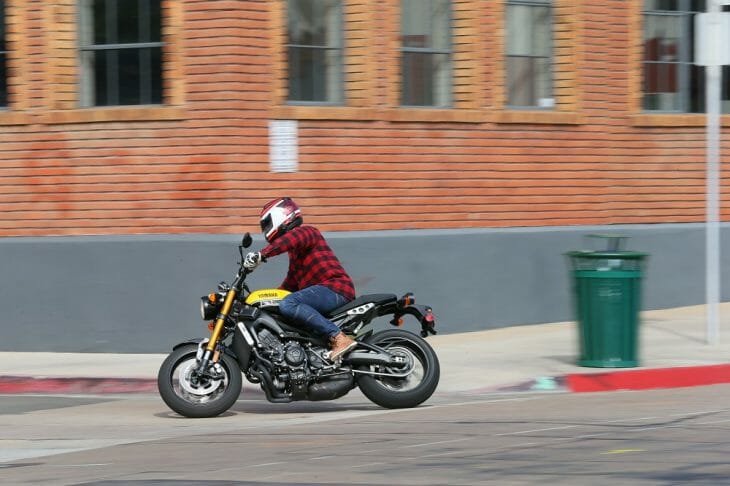 The refined throttle response to the FZ makes the XSR a brilliant town bike.
The refined throttle response to the FZ makes the XSR a brilliant town bike.
The riding position is an interesting case because although you sit 15mm higher than an FZ, I don’t fit as nicely thanks to the sculptured tank shrouds. These are not cut as low as I would have liked but, being aluminum and relatively inexpensive, you can always take a hammer to them a beat them into place (seriously, a Yamaha employee taller than me told me that).
Having said that, the leather/suede seat is one of the most comfortable standard seats I’ve tried this year. Eight hours in the saddle and I felt fine, which is more than I can say for many other bikes out there.
 Brushed side-panel is understated and looks beautiful.
Brushed side-panel is understated and looks beautiful.
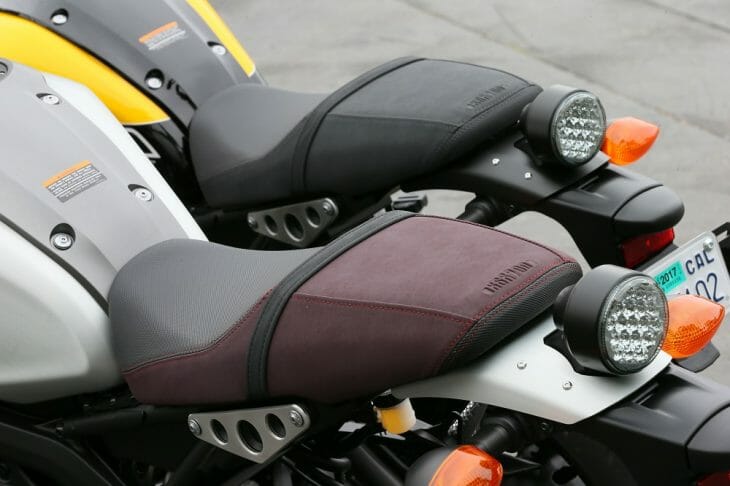 The seat is supremely comfortable – you can spend hours here, no problem.
The seat is supremely comfortable – you can spend hours here, no problem.
The XSR’s aesthetics make it feel like a bigger bike than it is. This comes down to the wide tank, seat shape and ’pegs that feel about 10mm too forward for my frame. If the skinny FZ-09 feels like a 750, the XSR feels like a genuine 900. Thus it might be a touch too intimidating for less experienced riders, which may be a good thing because the XSR is far from slow, something riders with a few extra miles under the belts will no doubt appreciate.
However, at the end of it all, the buying an XSR comes down to what image you want to project. And as odd as this feels to type, I greatly prefer the understated Matte Gray and Aluminum design to the 60th Anniversary yellow and black Speedblock edition. Normally I’d be a Speedblock kinda guy but I feel those colors should be reserved for racing machines (or at least race-able machines, like the YZF-R1) and I think using those colors on the XSR doesn’t suit them.
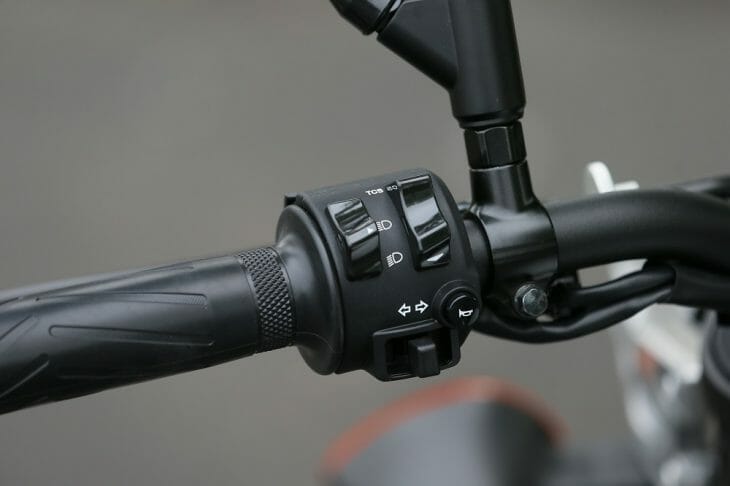 Traction control (that little TCS switch) has found a way to go back in time!
Traction control (that little TCS switch) has found a way to go back in time!
Regardless of my opinion on the colors, there is no denying this bike is an absolutely stellar example of how to mix old school charm with modern technology. Yamaha has a winner on its hands and hopefully they won’t have too much trouble trying to convince riders that a new bike that looks old is far more fun to rider, safer and easier to maintain than a poorly modified café racer.
I know which one I’d rather ride.
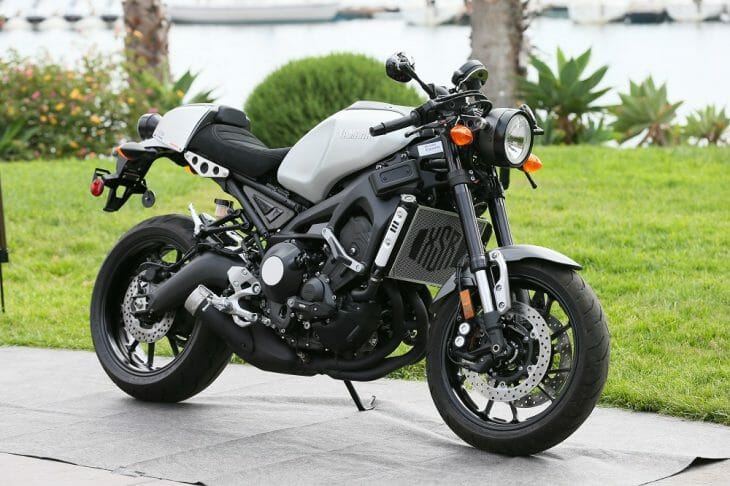
The Cult of Custom
It’s no longer enough to have ‘just a bike’. Maybe it never was. These days, if your bike doesn’t have a few individual touches, you’re just one of the squares, man.
Yamaha knows this and has thus designed a pretty comprehensive accessories catalog you can access for your new XSR900.
We had one of these bikes at the launch set up with café racer handlebars, rear cowl and suede seat, radiator guard, levers and engine protectors, and I have to say, it looked pretty dang sweet.
Yamaha’s had a pretty long collaboration with Roland Sands (so has almost everyone else, for that matter), and Roland has had more than a touch of influence on the design of not just this 900 but also the XSR700, a bike that, sadly, isn’t imported into the U.S, and bloody well should be.
Give it a few months and there will no doubt be an absolute ton of aftermarket pieces you can add to your XSR, along with the Yamaha ones found here.
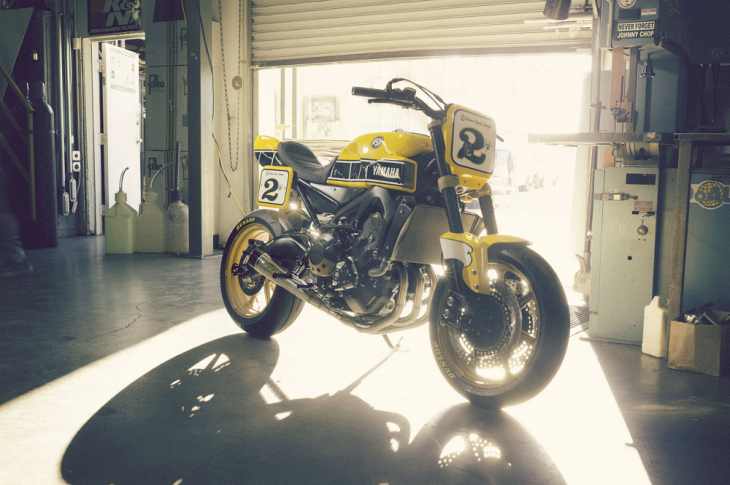
The Yellow Wasp
OK, even though I’m not 100 percent keen on the Speedblock color scheme of the production bike, I’m pretty in love with the Yellow Wasp, a machine created by Roland Sands using an FZ-09 that essentially became the prototype for the XSR.
It’s a few months old now, but this page details the stages the Yellow Wasp went through, starting out as a basic FZ-09 before Sands put all his funky race-inspired touches all over it.
It’s a pretty interesting story with a very special appearance in the video, which you can see below:
|
SPECIFICATIONS: Yamaha XSR900
|
|
Engine:
|
Three-cylinder inline, four-stroke, DOHC
|
|
Displacement:
|
847cc
|
|
Bore x stroke:
|
78 x 59.1mm
|
|
Horsepower:
|
N/A
|
|
Torque:
|
N/A
|
|
Compression ratio:
|
11.5:1
|
|
Transmission:
|
Six-speed
|
|
Chassis:
|
Twin spar aluminum
|
|
Front suspension:
|
41mm inverted fork, adjustable rebound & spring preload
|
|
Rear suspension:
|
Single shock absorber, adjustable rebound & spring preload
|
|
Front brake:
|
Twin 289mm discs, four-piston radial calipers, ABS
|
|
Rear brake:
|
Single 245mm disc, single-piston caliper, ABS
|
|
Front tire:
|
120/70 ZR17
|
|
Rear tire:
|
180/55 ZR17
|
|
Rake:
|
25°
|
|
Trail:
|
4.05 in.
|
|
Wheelbase:
|
56.69 in.
|
|
Seat height:
|
32.6 in.
|
|
Overall width:
|
32.08 in.
|
|
Overall length:
|
81.69 in.
|
|
Fuel capacity:
|
3.7 gal
|
|
Weight:
|
430 lbs (wet, claimed).
|
|
Color:
|
Matte Gray and Aluminum, 60th Anniversary Speedblock yellow/black
|
|
MSRP:
|
$9490 ($9990 60th Anniversary Speedblock)
|
You can read the original magazine story by clicking HERE.
For more Cycle News Standard motorcycle reviews, click HERE.
For more Yamaha motorcycle reviews, click HERE.